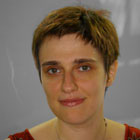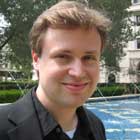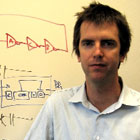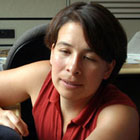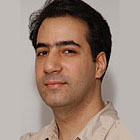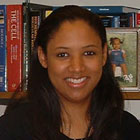
Our Junior Faculty: Wellspring of Young Talent
by Dean Thomas L. Magnanti, Vol. 3, No. 3, May 2006
To keep a lamp burning, we have to keep putting oil in it.
– Mother Teresa
MIT is great because its people are great. And, it is great because it is constantly renewing itself. Anyone walking down our hallways, past our research laboratories and classrooms, will be struck by the palpable excitement of our environment - the place bubbles with energy and enthusiasm as our faculty, staff, and students are literally inventing the future.
A key to our renewal and to the continued vitality of MIT is the constant infusion of new people with new ideas. It recently struck me that in the seven years that I've been dean, the School has hired 80 new faculty, mostly junior (we are on our way to almost 100 when this year's faculty hiring cycle concludes). Eighty! A number that represents the entire faculty for some schools of engineering.
Hiring these remarkable young people is essential to our continuing success. Benjamin Disraeli had it right when he said "Youth is the trustee of prosperity." Helping to support and nurture our junior colleagues, and then seeing them succeed and become leaders in their fields is certainly one of the most pleasurable and rewarding aspects of being dean and for all of us who are senior faculty.
MIT has been extraordinarily fortunate to be able to consistently attract superb talent across the School. I wish I could describe all our exceptional young faculty to you, but given space considerations, we are faced with the difficult task of selecting several from among those hired the past few years. The faculty we have chosen represent all of our academic departments and divisions and a cross section of our research and teaching. The good news is that we could have chosen dozens of other faculty to bring to your attention – with the same sense of joy, pride, and accomplishment.
I hope that from reading about those we have highlighted here you will catch the excitement of the leading-edge research and exceptional teaching talent we are so fortunate to have at MIT.
– Dean Thomas L. Magnanti
- Regina Barzilay
- Markus J. Buehler
- Drew Endy
- Anette "Peko" Hosoi
- Alan Jasanoff
- Kristala L. Jones Prather
- Nicholas Roy
- Devavrat Shah
- Krystyn J. Van Vliet
Regina Barzilay: Digesting story content with Newsblaster
A natural language processing specialist in the MIT Computer Science and Artificial Intelligence Laboratory, Regina Barzilay made Technology Review's 2005 "TR 35" list, a compilation of the 35 best innovators worldwide under age 35. Her innovation? Newsblaster, "a computer program able to recognize stories from different news services as being about the same basic subject, and then paraphrase elements from all of the stories to create a sumsmary," Technology Review reported. In general, the goal of her research is to enable robust methods for text processing that rely on statistical foundations to deliver rich linguistic analysis across the range of natural language applications. Barzilay received the Best Paper Award at the 2004 meeting of the Human Language Technology conference/North American chapter of the Association for Computational Linguistics. In 2005, the National Science Foundation gave her a CAREER (Faculty Early Career Development Program) Award. In 2006, she was named a Microsoft Faculty Fellow.
"Because of the range of research being conducted within EECS and the collaborative culture that exists here, I have had an excellent opportunity to learn about other research areas which influence my research in unforeseen ways."
Markus J. Buehler: Cracking the secrets of how materials break
How do cracks in materials form and spread? This question is a major theme of Markus Buehler's research and is essential to understanding many material deformation mechanisms. Recently, Buehler, principal investigator in the Atomistic Mechanics Modeling Group, published a paper in Nature on a breakthrough in his work. His atom-by-atom simulation of cracks forming and spreading might provide answers to how materials fail in nanoscale devices, airplanes, and even in the Earth itself during a quake. Buehler's theory helps explain experimental and computational observations that have been poorly understood, and it could impact a wide range of scientific and engineering disciplines. Moreover, his novel modeling techniques describe material behavior across the scale, from the atomic to the macroscopic. Buehler's group has conducted several recent studies on the deformation mechanics of chemically complex materials, including silicon, whose fracture mechanics were the focus of an article published in Physical Review Letters. The model described in the article is a significant step toward understanding the fracture mechanics of silicon, something that has long puzzled scientists.
"MIT provides an ideal intellectual environment to conduct interdisciplinary research, for example to link biology, chemistry, engineering, and materials science across the barriers of classical scientific disciplines. Development of physics-based atomistic or molecular-based models of biological materials might have significant impact in various fields. For example, it could help cure diseases, or provide engineers with new ideas of how to manufacture materials with improved mechanical and chemical properties and nanoscale features."
Drew Endy: Building the foundations for engineering biology
What do civil, environmental, and biological engineering have in common? For Drew Endy, who is trained in these three fields, they are about building infrastructure. In the former, that might mean a transportation system composed of bridges and roads; in the latter, it means synthetic, programmable biological systems engineered from standardized "parts." Endy and his colleagues in the new field of synthetic biology "are designing and building living systems that behave in predictable ways, that use interchangeable parts, and in some cases that operate with an expanded genetic code, which allows them to do things that no natural organism can," reports a 2004 Scientific American article. To make their job easier, Endy and others at MIT are standardizing biological building blocks, such as parts of cells, for the MIT Registry of Standard Biological Parts. With the support of the Alfred P. Sloan Foundation, Endy is also co-directing a study geared toward policy makers, scientists, and engineers on the benefits, as well as the ethical and security risks, of this emerging field.
"The great thing about being an engineer at MIT is that it's OK to admit when we don't know how to do something. There's enough deep engineering wisdom around campus that some folks remember what engineering fields were like before they got going. One great example and hero of mine is Tom Knight [senior research scientist in the Computer Science and Artificial Intelligence Laboratory]; Tom came up with the BioBricks framework for standard biological parts that everybody's using today."
Anette "Peko" Hosoi: Studying fluid dynamics and viscous flows, from snails to oceans
Aided by an onboard mucus factory that provides an unusual fluid used both for propulsion and traction, the garden-variety snail undulates along a variety of terrains and inclines - even upside down - showing that locomotion does not require regular surfaces. Building RoboSnails, robots with few moving parts that could have the potential to traverse complex, contaminated, or hostile terrain, Anette ("Peko") Hosoi's studies of gastropod locomotion also bring to light a number of other intriguing biomimetic issues. While traditional engineering design of conveying and transportation technologies relies heavily on rigid components, biological systems, such as snails, use flexible structures to perform similar functions, often resulting in improvements in efficiency, robustness, and/or versatility. Hosoi and her group are learning from these types of biological systems and are using a variety of tools, including mathematical modeling, experimentation, and numerical simulation, to incorporate similar flexibility into the optimal design of mechanical systems.
Hosoi's Doherty Professorship-funded research in the Hatsopoulos Microfluids Laboratory focuses on the experimental and numerical investigation of oceanic particle-laden flows. The findings should increase understanding of the potential risks in offshore construction, ocean exploration, and options for eliminating waste products.
"MIT is a remarkable institution. It would be tough to find any other place in the world with such a high concentration of technical knowledge and innovative thinkers. However, I believe that the most crucial ingredient in my research is the extraordinarily talented and creative students who make my job not only stimulating and rewarding, but also possible. Their dedication and fresh ideas can turn a good research program into an outstanding one."
Alan Jasanoff: Portraying the physiology of the mind through new MRI techniques
Alan Jasanoff, who conducts work in the Francis Bitter Magnet Laboratory and the McGovern Institute for Brain Research, is using an established technology - functional magnetic resonance imaging, or fMRI - in new ways to understand how physiological processes in the brain correlate with behavior. Currently, scientists studying behavior use fMRI to generate rapid, time-sequenced snapshots of the brain in action. This involves tracking how the flow of blood to different areas of the brain is activated by certain activities and feelings, such as learning and fear. Jasanoff is developing new imaging agents and high-resolution fMRI methods to map brain function on the molecular level - by directly reading the chemical signals brain cells use to communicate information. This would provide a more immediate and thus more precise snapshot of the brain at work. His studies of neural function in the brains of awake, behaving animals could advance the quest to understand the physiological underpinnings of the connection between the brain and human consciousness.
"MIT provides a great environment for our molecular-level brain imaging work because it enables my lab to interact with some of the world's best investigators in the collection of disciplines involved in our research. Here we have been able to build stimulating collaborations with scientists and engineers in five departments across campus."
Kristala L. Jones Prather: Exploring cutting-edge bioprocessing technologies
Prather is a young engineer who shows exceptional promise for doing creative research and teaching. So said the Office of Naval Research who selected her in June 2005 as one of 28 Young Investigators across the nation. The year before that, she had won the extremely competitive Camille and Henry Dreyfus New Faculty Award, given nationwide to only nine chemists and chemical engineers starting academic careers. In recognizing her outstanding research accomplishments and the bright future ahead of her, the award has helped her to set up her new lab where she focuses research on methods for designing and constructing novel pathways for production of organic compounds in E. coli. Her research will lead to new ways of synthesizing molecules from renewable resources, such as biomass, in place of petroleum feedstocks.
"Teaching MIT students is quite invigorating. There's always at least one person in the class who's thinking deeper about the subject, looking to learn more than you're sharing, but sometimes hoping to trip you up! Being an instructor in an MIT classroom is often the best place to learn more yourself."
Nicholas Roy: Helping robots learn to cope with uncertainty
To perform effectively, autonomous systems need not only sense their environment but also integrate information from around them into all decision making. Roy's research focuses on the problems that result from uncertainty in the world for mobile robots, such as sensor noise, incomplete knowledge, or unpredictable dynamics, and on how to teach robots to make decisions safely in planning, exploring the world, and managing human-robot interaction in real-world systems. Roy's research group in the Computer Science and Artificial Intelligence Laboratory works to build robust autonomous robots that can live in natural, dynamic worlds by learning from past experience. He has worked with mobile robots in a variety of environments and a wide range of applications, including a robotic tour guide, now in the Smithsonian, and a robot for assisting nurses and the elderly. As one of the instructors in a recently launched course offered jointly among the Departments of Aeronautics and Astronautics, Electrical Engineering and Computer Science, and Mechanical Engineering, Roy helped students produce final projects featured in a robotic "petting zoo" held in honor of the inauguration of MIT President Susan Hockfield in May 2005.
"I am continually astonished by the students who believe that there is nothing they cannot do and then go right ahead and show that they are right. It has been an absolute joy to teach and work with such people who have so much energy and enthusiasm for learning and inventing and creating new things out of thin air."
Devavrat Shah: Alleviating traffic jams in cyber space
Seeking to alleviate traffic jams in cyber space, Devavrat Shah's work in the theory and practice of networks has garnered a lot of attention. In 2005 the Institute for Operations Research and the Management Sciences (INFORMS) named him co-recipient of the George B. Dantzig Award honoring the best dissertation that is innovative and relevant to practice. (His dissertation addressed "Randomization and Heavy Traffic Theory: New Approaches for Switch Algorithms.") INFOCOM, the conference of the IEEE Communications Society that addresses key topics and issues related to computer communications, particularly traffic management and protocols, co-awarded Shah for the best paper in 2004. This year, the National Science Foundation gave Shah a prestigious five-year Faculty Early Career Development (CAREER) award to fund his research in implementable network algorithms, randomization, belief propagation, and heavy traffic. And, yes, he's even won the gold - the India Institute of Technology (IIT)-Bombay awarded him the President of India gold medal in 1999.
"The recent exciting development at the interface of Statistics, Physics and EECS has been "keeping me awake." These ideas will possibly lead to the development of implementable high-performance algorithms for networks in addition to interesting theoretical research."
Krystyn J. Van Vliet: Mechanical mapping of biomaterial interfaces
Nanoscale probing of surfaces - deforming materials at the most basic structural length scales - enables much more than measurement of mechanical properties, Krystyn Van Vliet has demonstrated. Her group develops experiments and simulations to understand the coupling between biochemical and mechanical states in systems as complex as living cells, using nanoscale contact to map the structure and molecular distributions of biomaterial interfaces. Van Vliet recently used this approach to analyze the mechanical properties of almost 600 different biomaterials in a matter of days - a task that would have taken weeks using conventional methods. The work, described in the cover story of the November 2005 issue of Advanced Materials, was a collaboration between Van Vliet's laboratory and researchers in the Department of Chemical Engineering who considered these polymers as stem cell substrates. Van Vliet received the 2006 Beckman Foundation Young Investigator award, which will support her research of the mechanical microenvironments that sustain or induce stem and cancer cell function.
"As my research is defined at the interface of materials, mechanics, chemistry, and biology, I have been fortunate to collaborate with engineers, scientists, and clinicians who have been generous with their time and ideas - people who synthesize the materials or molecules we seek to characterize, or who simulate the problem from an entirely different length or time scale. This type of interdisciplinary research provides me with the opportunity to continually learn about complex phenomena, such as the molecular response of a biological cell to mechanical cues, from several different perspectives."






